+ データを開く
データを開く
- 基本情報
基本情報
| 登録情報 |  | |||||||||
|---|---|---|---|---|---|---|---|---|---|---|
| タイトル | The NTD dimer and the interfacing LBD region of the AMPAR complex GluA3- TARP gamma2 in the desensitised state. | |||||||||
 マップデータ マップデータ | ||||||||||
 試料 試料 |
| |||||||||
 キーワード キーワード | AMPAR / ion channels / neurotransmission / MEMBRANE PROTEIN | |||||||||
| 機能・相同性 |  機能・相同性情報 機能・相同性情報Presynaptic depolarization and calcium channel opening / eye blink reflex / positive regulation of protein localization to basolateral plasma membrane / cerebellar mossy fiber / postsynaptic neurotransmitter receptor diffusion trapping / regulation of AMPA receptor activity / channel regulator activity / Trafficking of AMPA receptors / LGI-ADAM interactions / membrane hyperpolarization ...Presynaptic depolarization and calcium channel opening / eye blink reflex / positive regulation of protein localization to basolateral plasma membrane / cerebellar mossy fiber / postsynaptic neurotransmitter receptor diffusion trapping / regulation of AMPA receptor activity / channel regulator activity / Trafficking of AMPA receptors / LGI-ADAM interactions / membrane hyperpolarization / nervous system process / Synaptic adhesion-like molecules / protein targeting to membrane / voltage-gated calcium channel complex / protein heterotetramerization / neurotransmitter receptor localization to postsynaptic specialization membrane / neuromuscular junction development / parallel fiber to Purkinje cell synapse / Activation of AMPA receptors / AMPA glutamate receptor activity / transmission of nerve impulse / response to lithium ion / Trafficking of GluR2-containing AMPA receptors / AMPA glutamate receptor complex / asymmetric synapse / ionotropic glutamate receptor complex / regulation of receptor recycling / membrane depolarization / Unblocking of NMDA receptors, glutamate binding and activation / synaptic cleft / positive regulation of synaptic transmission, glutamatergic / regulation of postsynaptic membrane neurotransmitter receptor levels / voltage-gated calcium channel activity / response to fungicide / glutamate-gated receptor activity / glutamate-gated calcium ion channel activity / presynaptic active zone membrane / somatodendritic compartment / ionotropic glutamate receptor binding / ligand-gated monoatomic ion channel activity involved in regulation of presynaptic membrane potential / hippocampal mossy fiber to CA3 synapse / dendritic shaft / regulation of membrane potential / calcium channel regulator activity / transmitter-gated monoatomic ion channel activity involved in regulation of postsynaptic membrane potential / synaptic transmission, glutamatergic / response to calcium ion / postsynaptic density membrane / modulation of chemical synaptic transmission / Schaffer collateral - CA1 synapse / long-term synaptic potentiation / terminal bouton / amyloid-beta binding / presynaptic membrane / perikaryon / protein homotetramerization / dendritic spine / postsynaptic membrane / postsynaptic density / neuronal cell body / dendrite / glutamatergic synapse / cell surface / protein-containing complex / membrane / plasma membrane 類似検索 - 分子機能 | |||||||||
| 生物種 |   | |||||||||
| 手法 | 単粒子再構成法 / クライオ電子顕微鏡法 / 解像度: 3.77 Å | |||||||||
 データ登録者 データ登録者 | Pokharna A / Krieger J / Greger I / Ho H / Yamashita K / Cais O | |||||||||
| 資金援助 |  英国, 2件 英国, 2件
| |||||||||
 引用 引用 |  ジャーナル: Nature / 年: 2025 ジャーナル: Nature / 年: 2025タイトル: Architecture, dynamics and biogenesis of GluA3 AMPA glutamate receptors. 著者: Aditya Pokharna / Imogen Stockwell / Josip Ivica / Bishal Singh / Johannes Schwab / Carlos Vega-Gutiérrez / Beatriz Herguedas / Ondrej Cais / James M Krieger / Ingo H Greger /    要旨: AMPA-type glutamate receptors (AMPARs) mediate the majority of excitatory neurotransmission in the brain. Assembled from combinations of four core subunits, GluA1-4 and around 20 auxiliary subunits, ...AMPA-type glutamate receptors (AMPARs) mediate the majority of excitatory neurotransmission in the brain. Assembled from combinations of four core subunits, GluA1-4 and around 20 auxiliary subunits, their molecular diversity tunes information transfer and storage in a brain-circuit-specific manner. GluA3, a subtype strongly associated with disease, functions as both a fast-transmitting Ca-permeable AMPAR at sensory synapses, and as a Ca-impermeable receptor at cortical synapses. Here we present cryo-electron microscopy structures of the Ca-permeable GluA3 homomer, which substantially diverges from other AMPARs. The GluA3 extracellular domain tiers (N-terminal domain (NTD) and ligand-binding domain (LBD)) are closely coupled throughout gating states, creating interfaces that impact signalling and contain human disease-associated mutations. Central to this architecture is a stacking interaction between two arginine residues (Arg163) in the NTD dimer interface, trapping a unique NTD dimer conformation that enables close contacts with the LBD. Rupture of the Arg163 stack not only alters the structure and dynamics of the GluA3 extracellular region, but also increases receptor trafficking and the expression of GluA3 heteromers at the synapse. We further show that a mammalian-specific GluA3 trafficking checkpoint determines the conformational stability of the LBD tier. Thus, specific design features define communication and biogenesis of GluA3, offering a framework to examine this disease-associated glutamate receptor. | |||||||||
| 履歴 |
|
- 構造の表示
構造の表示
| 添付画像 |
|---|
- ダウンロードとリンク
ダウンロードとリンク
-EMDBアーカイブ
| マップデータ |  emd_52328.map.gz emd_52328.map.gz | 460.8 MB |  EMDBマップデータ形式 EMDBマップデータ形式 | |
|---|---|---|---|---|
| ヘッダ (付随情報) |  emd-52328-v30.xml emd-52328-v30.xml emd-52328.xml emd-52328.xml | 18.6 KB 18.6 KB | 表示 表示 |  EMDBヘッダ EMDBヘッダ |
| FSC (解像度算出) |  emd_52328_fsc.xml emd_52328_fsc.xml | 17.1 KB | 表示 |  FSCデータファイル FSCデータファイル |
| 画像 |  emd_52328.png emd_52328.png | 46.6 KB | ||
| マスクデータ |  emd_52328_msk_1.map emd_52328_msk_1.map | 512 MB |  マスクマップ マスクマップ | |
| Filedesc metadata |  emd-52328.cif.gz emd-52328.cif.gz | 6.7 KB | ||
| その他 |  emd_52328_half_map_1.map.gz emd_52328_half_map_1.map.gz emd_52328_half_map_2.map.gz emd_52328_half_map_2.map.gz | 475.6 MB 475.6 MB | ||
| アーカイブディレクトリ |  http://ftp.pdbj.org/pub/emdb/structures/EMD-52328 http://ftp.pdbj.org/pub/emdb/structures/EMD-52328 ftp://ftp.pdbj.org/pub/emdb/structures/EMD-52328 ftp://ftp.pdbj.org/pub/emdb/structures/EMD-52328 | HTTPS FTP |
-検証レポート
| 文書・要旨 |  emd_52328_validation.pdf.gz emd_52328_validation.pdf.gz | 1.2 MB | 表示 |  EMDB検証レポート EMDB検証レポート |
|---|---|---|---|---|
| 文書・詳細版 |  emd_52328_full_validation.pdf.gz emd_52328_full_validation.pdf.gz | 1.2 MB | 表示 | |
| XML形式データ |  emd_52328_validation.xml.gz emd_52328_validation.xml.gz | 26.9 KB | 表示 | |
| CIF形式データ |  emd_52328_validation.cif.gz emd_52328_validation.cif.gz | 35.3 KB | 表示 | |
| アーカイブディレクトリ |  https://ftp.pdbj.org/pub/emdb/validation_reports/EMD-52328 https://ftp.pdbj.org/pub/emdb/validation_reports/EMD-52328 ftp://ftp.pdbj.org/pub/emdb/validation_reports/EMD-52328 ftp://ftp.pdbj.org/pub/emdb/validation_reports/EMD-52328 | HTTPS FTP |
-関連構造データ
| 関連構造データ |  9hpfMC  9hpcC  9hpdC  9hpeC  9hpgC  9hpkC  9qfhC M: このマップから作成された原子モデル C: 同じ文献を引用 ( |
|---|---|
| 類似構造データ | 類似検索 - 機能・相同性  F&H 検索 F&H 検索 |
- リンク
リンク
| EMDBのページ |  EMDB (EBI/PDBe) / EMDB (EBI/PDBe) /  EMDataResource EMDataResource |
|---|---|
| 「今月の分子」の関連する項目 |
- マップ
マップ
| ファイル |  ダウンロード / ファイル: emd_52328.map.gz / 形式: CCP4 / 大きさ: 512 MB / タイプ: IMAGE STORED AS FLOATING POINT NUMBER (4 BYTES) ダウンロード / ファイル: emd_52328.map.gz / 形式: CCP4 / 大きさ: 512 MB / タイプ: IMAGE STORED AS FLOATING POINT NUMBER (4 BYTES) | ||||||||||||||||||||||||||||||||||||
|---|---|---|---|---|---|---|---|---|---|---|---|---|---|---|---|---|---|---|---|---|---|---|---|---|---|---|---|---|---|---|---|---|---|---|---|---|---|
| 投影像・断面図 | 画像のコントロール
画像は Spider により作成 | ||||||||||||||||||||||||||||||||||||
| ボクセルのサイズ | X=Y=Z: 0.826 Å | ||||||||||||||||||||||||||||||||||||
| 密度 |
| ||||||||||||||||||||||||||||||||||||
| 対称性 | 空間群: 1 | ||||||||||||||||||||||||||||||||||||
| 詳細 | EMDB XML:
|
-添付データ
-マスク #1
| ファイル |  emd_52328_msk_1.map emd_52328_msk_1.map | ||||||||||||
|---|---|---|---|---|---|---|---|---|---|---|---|---|---|
| 投影像・断面図 |
| ||||||||||||
| 密度ヒストグラム |
-ハーフマップ: #1
| ファイル | emd_52328_half_map_1.map | ||||||||||||
|---|---|---|---|---|---|---|---|---|---|---|---|---|---|
| 投影像・断面図 |
| ||||||||||||
| 密度ヒストグラム |
-ハーフマップ: #2
| ファイル | emd_52328_half_map_2.map | ||||||||||||
|---|---|---|---|---|---|---|---|---|---|---|---|---|---|
| 投影像・断面図 |
| ||||||||||||
| 密度ヒストグラム |
- 試料の構成要素
試料の構成要素
-全体 : homomeric AMPAR complex GluA3 in tandem with the auxiliary subuni...
| 全体 | 名称: homomeric AMPAR complex GluA3 in tandem with the auxiliary subunit TARP gamma2 |
|---|---|
| 要素 |
|
-超分子 #1: homomeric AMPAR complex GluA3 in tandem with the auxiliary subuni...
| 超分子 | 名称: homomeric AMPAR complex GluA3 in tandem with the auxiliary subunit TARP gamma2 タイプ: complex / ID: 1 / 親要素: 0 / 含まれる分子: #1 |
|---|---|
| 由来(天然) | 生物種:  |
-分子 #1: Isoform Flip of Glutamate receptor 3,Voltage-dependent calcium ch...
| 分子 | 名称: Isoform Flip of Glutamate receptor 3,Voltage-dependent calcium channel gamma-2 subunit タイプ: protein_or_peptide / ID: 1 / コピー数: 2 / 光学異性体: LEVO |
|---|---|
| 由来(天然) | 生物種:  |
| 分子量 | 理論値: 132.665734 KDa |
| 組換発現 | 生物種:  Homo sapiens (ヒト) Homo sapiens (ヒト) |
| 配列 | 文字列: GDYKDDDDKF PNTISIGGLF MRNTVQEHSA FRFAVQLYNT NQNTTEKPFH LNYHVDHLDS SNSFSVTNAF CSQFSRGVYA IFGFYDQMS MNTLTSFCGA LHTSFVTPSF PTDADVQFVI QMRPALKGAI LSLLSYYKWE KFVYLYDTER GFSVLQAIME A AVQNNWQV ...文字列: GDYKDDDDKF PNTISIGGLF MRNTVQEHSA FRFAVQLYNT NQNTTEKPFH LNYHVDHLDS SNSFSVTNAF CSQFSRGVYA IFGFYDQMS MNTLTSFCGA LHTSFVTPSF PTDADVQFVI QMRPALKGAI LSLLSYYKWE KFVYLYDTER GFSVLQAIME A AVQNNWQV TARSVGNIKD VQEFRRIIEE MDRRQEKRYL IDCEVERINT ILEQVVILGK HSRGYHYMLA NLGFTDILLE RV MHGGANI TGFQIVNNEN PMVQQFIQRW VRLDEREFPE AKNAPLKYTS ALTHDAILVI AEAFRYLRRQ RVDVSRRGSA GDC LANPAV PWSQGIDIER ALKMVQVQGM TGNIQFDTYG RRTNYTIDVY EMKVSGSRKA GYWNEYERFV PFSDQQISND SSSS ENRTI VVTTILESPY VMYKKNHEQL EGNERYEGYC VDLAYEIAKH VGIKYKLSIV GDGKYGARDP ETKIWNGMVG ELVYG RADI AVAPLTITLV REEVIDFSKP FMSLGISIMI KKPQKSKPGV FSFLDPLAYE IWMCIVFAYI GVSVVLFLVS RFSPYE WHL EDNNEEPRDP QSPPDPPNEF GIFNSLWFSL GAFMQQGCDI SPRSLSGRIV GGVWWFFTLI IISSYTANLA AFLTVER MV SPIESAEDLA KQTEIAYGTL DSGSTKEFFR RSKIAVYEKM WSYMKSAEPS VFTKTTADGV ARVRKSKGKF AFLLESTM N EYIEQRKPCD TMKVGGNLDS KGYGVATPKG SALGTPVNLA VLKLSEQGIL DKLKNKWWYD KGECGAKDSG SKDKTSALS LSNVAGVFYI LVGGLGLAMM VALIEFCYKS RAESKRMKLT KNTQNFKPAP AGGSGSGGLF DRGVQMLLTT VGAFAAFSLM TIAVGTDYW LYSRGVCKTK SVSENETSKK NEEVMTHSGL WRTCCLEGNF KGLCKQIDHF PEDADYEADT AEYFLRAVRA S SIFPILSV ILLFMGGLCI AASEFYKTRH NIILSAGIFF VSAGLSNIIG IIVYISANAG DPSKSDSKKN SYSYGWSFYF GA LSFIIAE MVGVLAVHMF IDRHKQLRAT ARATDYLQAS AITRIPSYRY RYQRRSRSSS RSTEPSHSRD ASPVGVKGFN TLP STEISM YTLSRDPLKA ATTPTATYNS DRDNSFLQVH NCIQKDSKDS LHANTANRRT TPV UniProtKB: Glutamate receptor 3, Voltage-dependent calcium channel gamma-2 subunit |
-分子 #2: 2-acetamido-2-deoxy-beta-D-glucopyranose
| 分子 | 名称: 2-acetamido-2-deoxy-beta-D-glucopyranose / タイプ: ligand / ID: 2 / コピー数: 2 / 式: NAG |
|---|---|
| 分子量 | 理論値: 221.208 Da |
| Chemical component information | 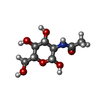 ChemComp-NAG: |
-分子 #3: water
| 分子 | 名称: water / タイプ: ligand / ID: 3 / コピー数: 1 / 式: HOH |
|---|---|
| 分子量 | 理論値: 18.015 Da |
| Chemical component information | 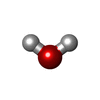 ChemComp-HOH: |
-実験情報
-構造解析
| 手法 | クライオ電子顕微鏡法 |
|---|---|
 解析 解析 | 単粒子再構成法 |
| 試料の集合状態 | particle |
- 試料調製
試料調製
| 緩衝液 | pH: 8 |
|---|---|
| 凍結 | 凍結剤: ETHANE |
- 電子顕微鏡法
電子顕微鏡法
| 顕微鏡 | TFS KRIOS |
|---|---|
| 撮影 | フィルム・検出器のモデル: GATAN K3 BIOQUANTUM (6k x 4k) 平均電子線量: 40.0 e/Å2 |
| 電子線 | 加速電圧: 300 kV / 電子線源:  FIELD EMISSION GUN FIELD EMISSION GUN |
| 電子光学系 | 照射モード: FLOOD BEAM / 撮影モード: BRIGHT FIELD / Cs: 2.7 mm / 最大 デフォーカス(公称値): 2.4 µm / 最小 デフォーカス(公称値): 1.2 µm |
| 実験機器 |  モデル: Titan Krios / 画像提供: FEI Company |
 ムービー
ムービー コントローラー
コントローラー










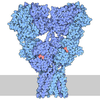
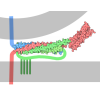


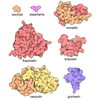

 X (Sec.)
X (Sec.) Y (Row.)
Y (Row.) Z (Col.)
Z (Col.)













































